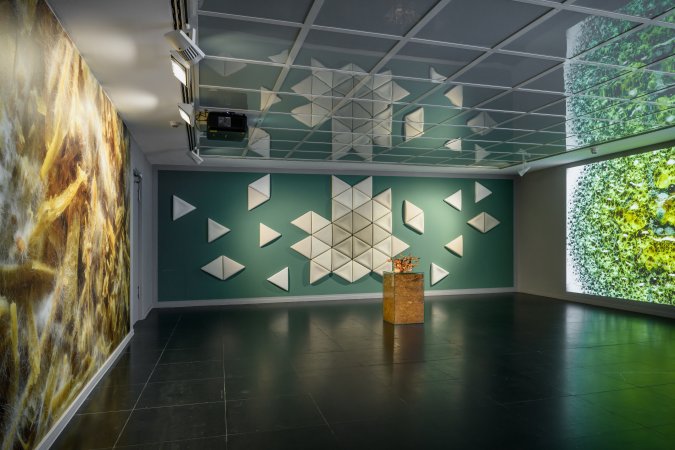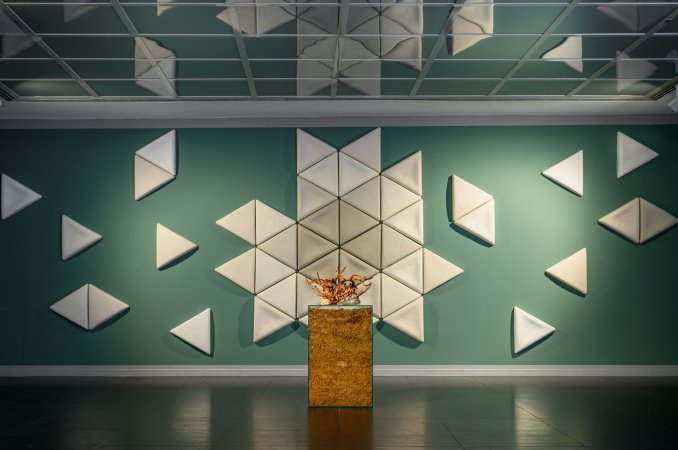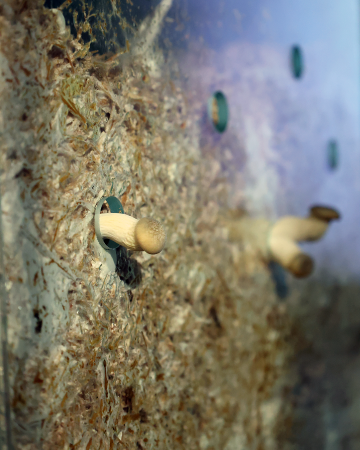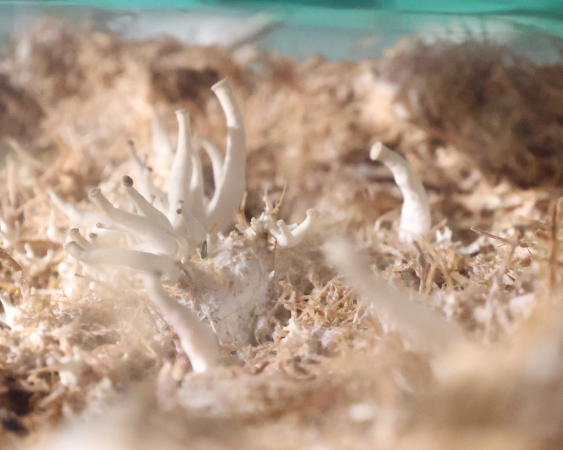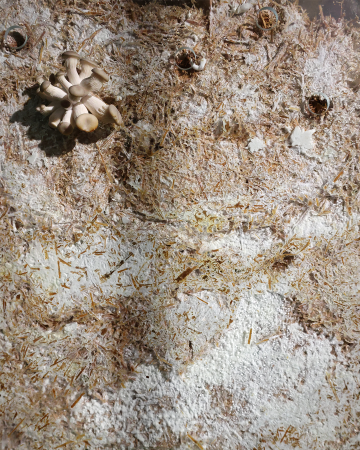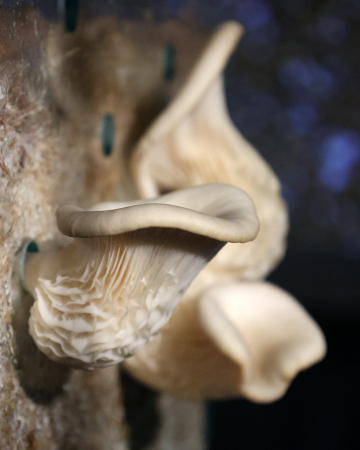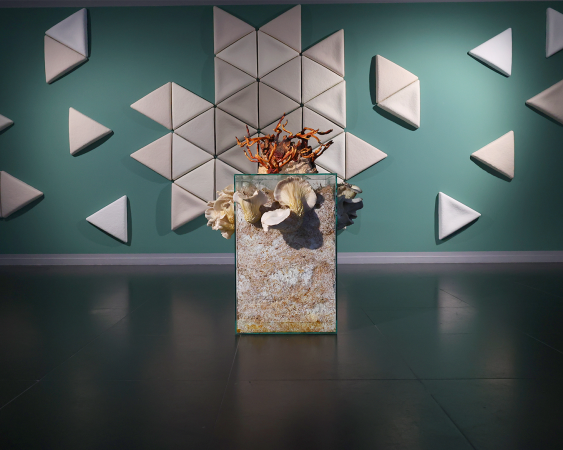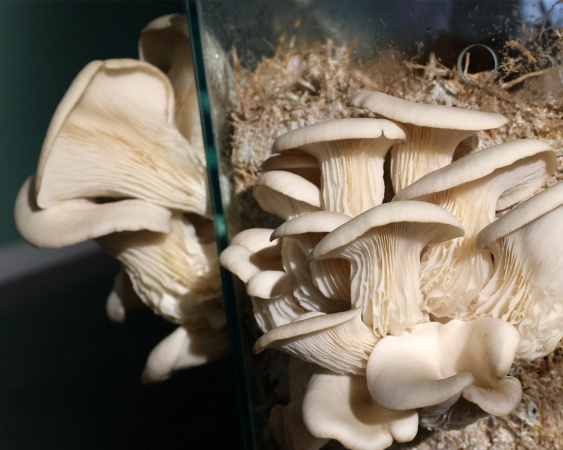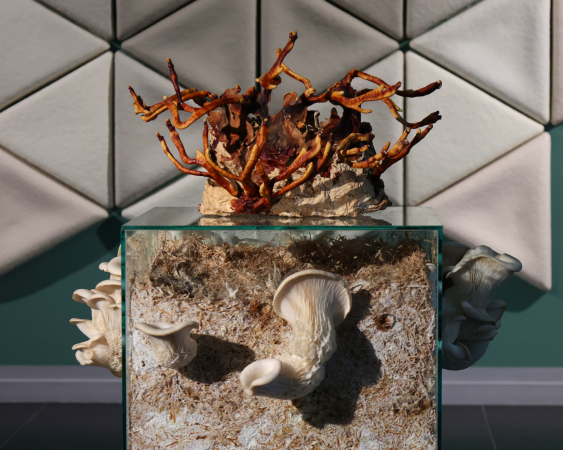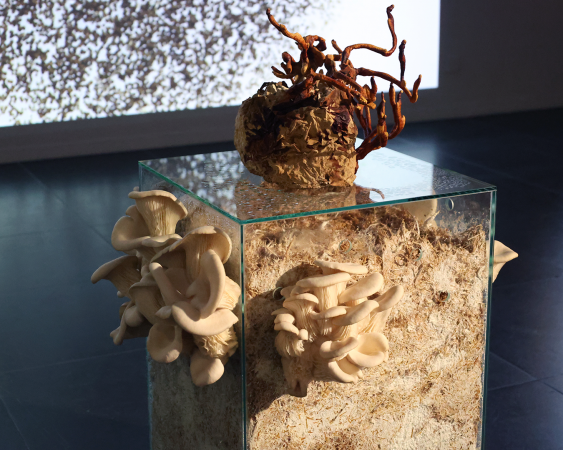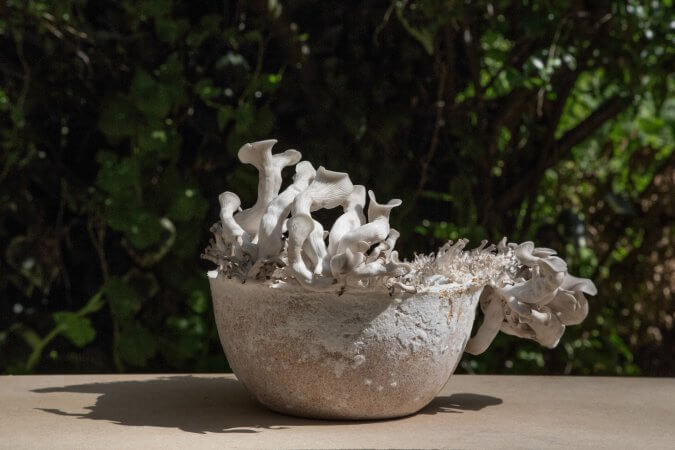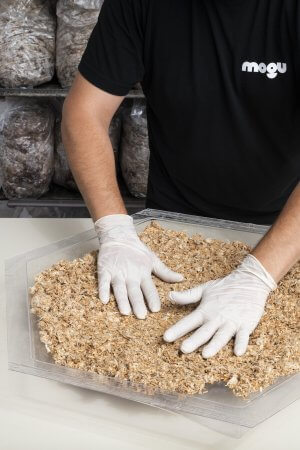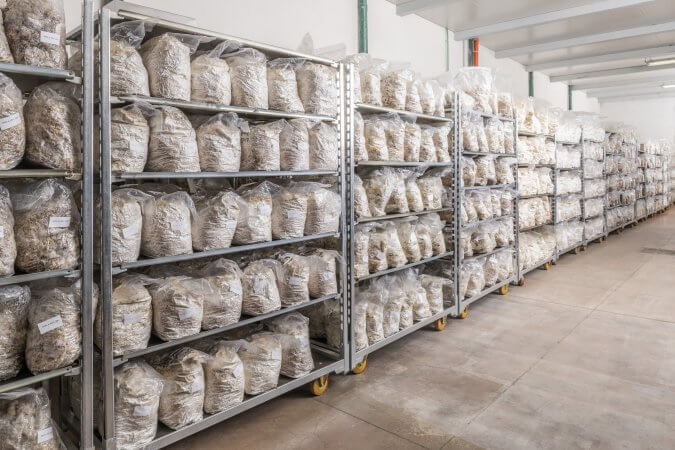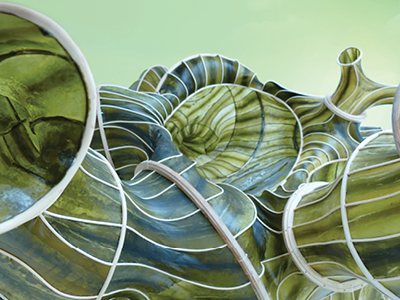Maurizio Montalti
RECIPROCITY // Mogu Acoustic ASPEN Tiles, 2023
Bio-fabricated mycelium-composite acoustic tiles, grown by means of fungal fermentation on low value substrates/residues, including hemp, cotton, and mycelium biomasses
Triangle-shaped modules, each one 45,5 x 39,8 cm
RECIPROCITY // The Alchemist – Ganoderma lucidum, 2021
Fungal Biomass and fruiting Bodies/mushrooms, cultivated on agro-industrial residues, including hemp straw and sawdust
Anamorphous volume, inscribed in full volume of 75x75x45 cm
Courtesy Maurizio Montalti / Mogu
RECIPROCITY // The Lower Fungi, filmed by Wim van Egmond, 2023
Film comprising a customized montage of high-quality timelapse films portraying fungal growth and behavior, as based on high-res micro-photography
13:30 min
RECIPROCITY // Metabolic Transformation, 2023
Film still from One Minute/Four Seconds shot by Wim van Edgmond, commissioned 2016 for Fungal Futures, curated by Officina Corpuscoli / Maurizio Montalti
Macro-photography, printed wallpaper mounted on wall
420 x 260 cm
Courtesy Officina Corpuscoli / Maurizio Montalti & Wim van Egmond
Maurizio Montalti is an artist, innovation researcher and entrepreneur with an engineering background. He works at the intersection of biotechnology and for over a decade now has been pioneering the development of sustainable and forward-thinking materials.
Montalti’s work revolves around a comprehensive understanding of life cycles, the interplay of becoming and decaying. He investigates various organisms and natural processes within a holistic framework of which humans are an integral part. Montalti employs methods that explore biological processes as a foundation for creating biological materials. He sees his work with fungi as representing a collaboration between humans and non-human organisms, all functioning as part of a living system. Montalti’s knowledge is rooted in theoretical and speculative ideas about new forms of coexistence, which have translated into practical actions.
What is commonly referred to as a mushroom is the reproductive structure (fruiting body) of a larger living organism, the mycelium. This mycelium is mostly invisible, growing as long filamentous strands in the soil or within deceased, nutrient-rich organisms. Mycelium refers to a network of thread-like fungal filaments (hyphae) that are so fine they are invisible to the naked eye. The filament network can become so dense that it forms a compact structure.
For the exhibition Bending the Curve, Montalti has designed a spatial installation titled RECIPROCITY. The installation reveals a mycelium-created cycle of elements and transformative processes to viewers. Montalti’s installation consists of different elements that expose the invisible. It includes a wall installation made of mycelium modules, a photographic close-up of mycelial threads in organic material, a film depicting the growth of mold fungi, a glass object, inside of which a substrate inoculated with mushroom spores can be seen, and with a mushroom sculpture on its top.
Montalti’s artistic practice is rooted in the fact that in nature, death and decay of biological cells and bodies are prerequisites for the emergence of new life. His work emerges from this natural process and the central role that fungi play in the environment as decomposing agents. They break down dead cells and transform them into substrate to become nourishment for new life of other organisms.
The title of the spatial installation encapsulates the artist’s central stance. Reciprocity means that every living being, human or non-human, is in a mutual relationship with all other living beings. Humans live in a coevolutionary interrelationship with other animals, plants, bacteria, viruses and fungi. This implies that changes and developments in species react to each other. By choosing the title of his work – Reciprocity – the artist references the insights of biologist and philosopher Lynn Margulis (1938 – 2011), who devoted her life and research to the evolutionary theory of symbiogenesis. This describes the emergence and development of life-communities in which different organisms closely interact and can only carry out their life-related functions in mutual dependence. Margulis conducted research on microorganisms like algae, bacteria, yeasts and fungi, which, in symbiosis with other organisms, induce changes in DNA and thus contribute to the emergence of new species.
At the center of the Reciprocity installation is the living sculpture, The Alchemist – Ganoderma lucidum. This organic sculpture consists of a grown mushroom body, a mature fruiting body that retains its shape through drying. The transparent glass base on which the sculpture stands contains substrate inoculated with mushroom spores that will develop over the course of the exhibition. It is not the sculpture that is alive, but the content of the base. This effectively reverses the way in which presentation has conventionally been prioritized in art museums. The title The Alchemist refers to the historical discipline that explored the properties of substances and their reactions, often with the goal of transforming them into valuable gold.
While plants produce their nutrients from sunlight and air through photosynthesis, fungi, like animals, derive their energy by digesting living or dead organic matter, as animals do. They grow and branch out, absorbing nutrients directly through their cell walls. The mycelium secretes enzymes that break down and absorb sugars from the material. In a natural setting, one of their primary functions is to break down dead material and organic matter, returning nutrients to the soil for plants to take up once more. The speed at which they do this plays a crucial role in how regeneration occurs in ecosystems.
Montalti views the natural decay process of fungi as a symbol for the cycle of all things and all life, in which death and decay are necessary to make room for new life forms and processes. Montalti represents an attitude held by numerous artists and innovative researchers today who produce their work with awareness of a socio-ecological transformation and their responsibility within that. The metaphor is insufficient for them: they move from metaphor into real implementation and action.
Montalti is a co-founder of the Italian company SQIM and the brands Mogu and Ephea, which produce biomaterials using mycelium through biodesign for interior design and textile production.
The start-ups are part of a transformation under way towards nature-inspired and sustainable materials and a new economy. With the Mogu company, Montalti places the idea of a partnership with non-human organisms at the center of his entrepreneurial activity. The concepts of reciprocity and co-creation are central to both his artistic work and his entrepreneurial endeavors.
Part of RECIPROCITY is the wall object consisting of mycelium modules. The acoustic panel system, triangular mycelium shapes, is produced by the artist in his co-founded start-up MOGU. The mycelium modules generate acoustic insulation due to the porous structure. The objects are biologically produced and biodegradable. By controlling humidity, temperature, substrate composition and the use of mineral pigments, different types of mycelium with varying strengths, densities and colors can be produced. With their goal of being part of an ecological transformation, Maurizio Montalti and his collaborators at Mogu have expanded the range of mycelium-based products and developed standardized production series.
The film The Lower Fungi and the macrophotography Metabolic Transformation are the result of a collaboration between microphotographer Wim van Egmond and Maurizio Montalti. Accelerated time-lapse footage of mushroom growth, observed through microscopes and stereoscopes, has resulted in high-resolution images. The macrophotography features the same type of mushroom from which the Mogu Acoustic ASPEN tiles are made.
Biomimicry, i.e., the knowledge and application of natural forms, processes and ecosystems to human actions, is a central part of Montalti’s artistic practice. In 2010, he founded the multidisciplinary studio Officinia Corpuscoli in the Netherlands. Here scientists and designers research biological processes and the connection between human and non-human beings. In particular, Montalti collaborated closely with mycologists (fungus scientists) and researchers from the University of Utrecht and the Fungal Biodiversity Centre CBS to explore diverse forms of mycelium and their potential as solutions to societal challenges. Jointly with them, Montalti developed methods that harness the biological properties of mycelium to create biobased and biodegradable products as alternatives to traditional products that often environmentally harmful.
“In nature, and that’s where you have to look if you want to learn something new, nothing disappears. It simply changes shape.” – Maurizio Montalti
Maurizio Montalti (IT) is an Italian designer, researcher, educator, and entrepreneur with a Master’s degree in Conceptual Design from the Design Academy Eindhoven (NL) and in Industrial Engineering and Management from the Università di Bologna (IT). He is the founder and creative director of Officina Corpuscoli, based in Amsterdam (NL) since 2010, where he conducts design research. Additionally, he is a co-founder, designer, and director of research and development at Mogu, a design company specializing in the development of high-performance solutions and products based on mycelium. He served as the co-director of the MAD Master’s program (Materialisation in Art and Design) at the Sandberg Instituut in Amsterdam (NL), conducted research at the Design Academy Eindhoven (NL), and currently holds the position of artistic director at DAS – Design Akademie Saaleck (DE). Furthermore, he teaches at various Dutch and international academies and universities. His work has received numerous awards and has been exhibited worldwide in renowned museums, galleries, and institutions, including the Museum of Modern Art in New York (US), the Centre Pompidou in Paris (FR), the Design Museum in London (UK), the Triennale di Milano (IT), the MAXXI in Rome (IT), and the Museum für Angewandte Kunst in Vienna (AT).
Sieh dir diesen Beitrag auf Instagram an

